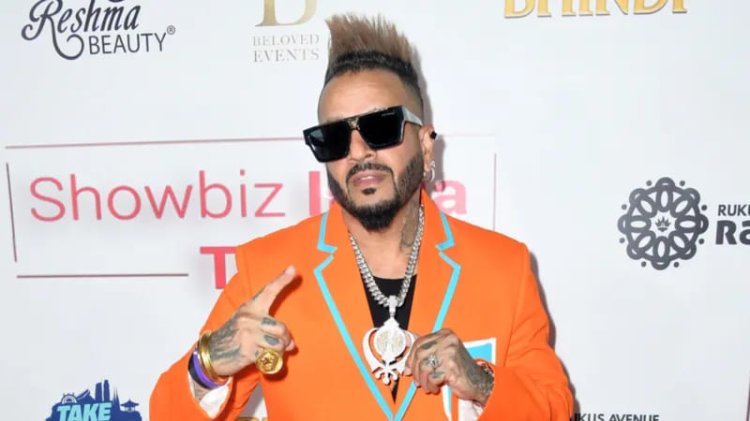Punjabi Hip-Hop Goes Global: Traditional Bhangra Outfits Get Modern Makeover
Leela Adwani |Jun 03, 2025
Punjabi hip-hop artists are transforming traditional bhangra fashion on the global stage, with performers like Diljit Dosanjh leading a cultural style revolution that blends heritage with contemporary Western influences.
Diljit Dosanjh made history at the Met Gala with his maharajah-inspired ensemble. The 41-year-old singer became the only Punjabi musician to perform at Coachella. Moreover, his Met Gala debut left a lasting impression on global fashion circles.

Designer Prabal Gurung created Dosanjh's opulent ivory and gold outfit. The ensemble featured a feathered bejewelled turban that trended in India for weeks. Additionally, he wore a diamond necklace inspired by a Cartier piece from Punjab's royal heritage.
The complete look included a Panthère de Cartier watch and a jewel-studded sword. Furthermore, his cape featured a map of Punjab embroidered on the back with Gurmukhi script letters. This attention to cultural detail demonstrated his commitment to representing Punjabi identity globally.
Evolution of Punjabi Hip-Hop Fashion
Fusion of Traditional and Western Elements
Dosanjh has carved out a unique fashion niche alongside his musical success. He consistently melds traditional Punjabi styles with Western influences. Moreover, his signature look includes anti-fit trousers, chunky sneakers, and stacks of necklaces paired with colorful turbans.
This distinctive form of self-expression has captured millions of imaginations worldwide. His style choices have led to interesting reinventions in traditional Punjabi attire. Subsequently, his influence extends far beyond music into fashion and cultural identity.

Global Impact on Bhangra Culture
Traditional bhangra performances are experiencing significant style transformations. High-intensity competitions in California now require high-performance sneakers instead of traditional footwear. Similarly, basement bhangra nights in Berlin feature crop tops and deconstructed pants.
Punjabi music itself has become a global subculture. The genre's high energy and lyrics featuring international cities and luxury brands resonate worldwide. Therefore, fashion choices naturally evolved to match this cosmopolitan musical identity.
Influential Punjabi Musicians and Their Style Impact
Regional Trendsetters
Punjabi-Canadian singer Jazzy B previously influenced regional fashion trends significantly. His cookie-sized rings, plus-sized Kanda pendants, and silver blonde hair tints became widely popular. However, his influence remained primarily regional rather than global.

More recently, other artists have contributed distinctive style elements. Badshah's yellow-tinted glasses, Yo Yo Honey Singh's baggy hoodies, and AP Dhillon's Louis Vuitton bombers gained popularity among Punjabi youth. Additionally, Dhillon's Chanel watches became aspirational accessories.
Global Reach vs Regional Influence
While these artists significantly influenced regional style, Dosanjh achieved global recognition. His style appeals to both the Sikh diaspora and broader international audiences. Moreover, merchandise from his world tour sold out within hours of release.
AP Dhillon's appearances at Paris Couture Week created aspiration among Punjabi youth globally. These international fashion moments demonstrate how Punjabi artists are transcending regional boundaries. Therefore, their influence now shapes global fashion conversations.
Cultural Roots of Fashion Evolution
Western Pop Culture Influence
Cultural experts attribute this fashion reinvention to Western pop culture exposure. Most Punjabi artists live and perform in Western countries. Subsequently, their style naturally incorporates both traditional and contemporary Western elements.
Art historian Alka Pande explains that "Punjabi men are inventive" and the region embraces fusion and hybridity. The Punjabi diaspora particularly exemplifies this trend. Furthermore, even in challenging circumstances, they remain "showmen of their lives."
Historical Context of Style Evolution
The Punjabi diaspora community's growth spawned a new generation of musicians. These artists began mixing modern hip-hop sounds with traditional Punjabi aesthetics. Moreover, their distinct style lexicon includes gold chains, faux fur jackets, plus-sized accessories, braids, and beards.
This unique aesthetic has inspired media articles, books, and doctoral theses on South Asian culture. The style evolution represents a significant cultural shift in how Punjabi identity is expressed globally. Therefore, fashion becomes a vehicle for cultural preservation and innovation.
Economic and Social Impact in Punjab
Luxury Brand Adoption
Punjab absorbed logo fashion rapidly when luxury brands arrived in the 2000s. For Punjabis, who are largely a farming community, luxury fashion represented aspirational uprising. Moreover, it symbolized how success and prosperity should appear.
Acclaimed singer Rabbi Shergill describes this as "the movement of the Punjabi identity from a farmer to a global consumer." These fashion choices respond to the hyper-capitalist world. Additionally, performers naturally reflect the times they live in.
Androgynous and Rooted Style Approach
Interestingly, Punjabi musicians' style remains rooted and androgynous rather than hyper-masculine. Artists may wear Balenciaga or Manish Malhotra's creations while performing globally. However, they always maintain their Punjabi identity prominently.
Dosanjh exemplified this with his Met Gala maharajah look. Pande notes that "the popularity of his androgynous style was waiting to happen." Therefore, authenticity combined with global appeal creates powerful fashion statements.
Contemporary Fashion Retail and Merchandise
Modern Bhangra Performance Attire
Local bhangra performances no longer rely solely on traditional "dhoti-kurta-koti" costume sets. Performance attire now includes sneakers, typographic T-shirts, deconstructed bottoms, and denim. Moreover, these modern items attract significant customer demand.
Harinder Singh, owner of brand 1469, confirms that such contemporary items are "highly sought after by customers." His stores stock accessories popularized by Punjab's music stars. Additionally, he personally owns turbans in over 100 different shades.
Cultural Accessories Market
Singh's merchandise includes Phulkari turbans worn by Dosanjh and Kanda pendants popularized by veteran artist Pammi Bai. These accessories bridge traditional craftsmanship with contemporary style statements. Furthermore, they allow fans to emulate their favorite artists' looks.
The retail success demonstrates how music influence translates into commercial fashion opportunities. Traditional artisans benefit from renewed interest in cultural accessories. Therefore, the fashion evolution supports both cultural preservation and economic development.
Broader Cultural Impact
Influence on Overall Men's Style
Punjab's overall men's style now bears cosmopolitan influences. Young poet Gurpreet Saini sources shawls printed with ombre Gurmukhi letters from his hometown. Moreover, he acknowledges influence from music icons like folk singer Gurdas Mann.
These personal style choices evolved from individual flair into broader fashion statements. Subsequently, they became cultural signatures that recast Punjabi identity. The transformation occurs through rhythm, hybridity, and rooted self-expression.
This fashion evolution represents more than aesthetic change. It demonstrates how cultural identity adapts and thrives in global contexts while maintaining authentic roots. Therefore, Punjabi hip-hop fashion serves as a model for cultural evolution in the modern world.
- Tag






Comments
Sort by Newest | Popular